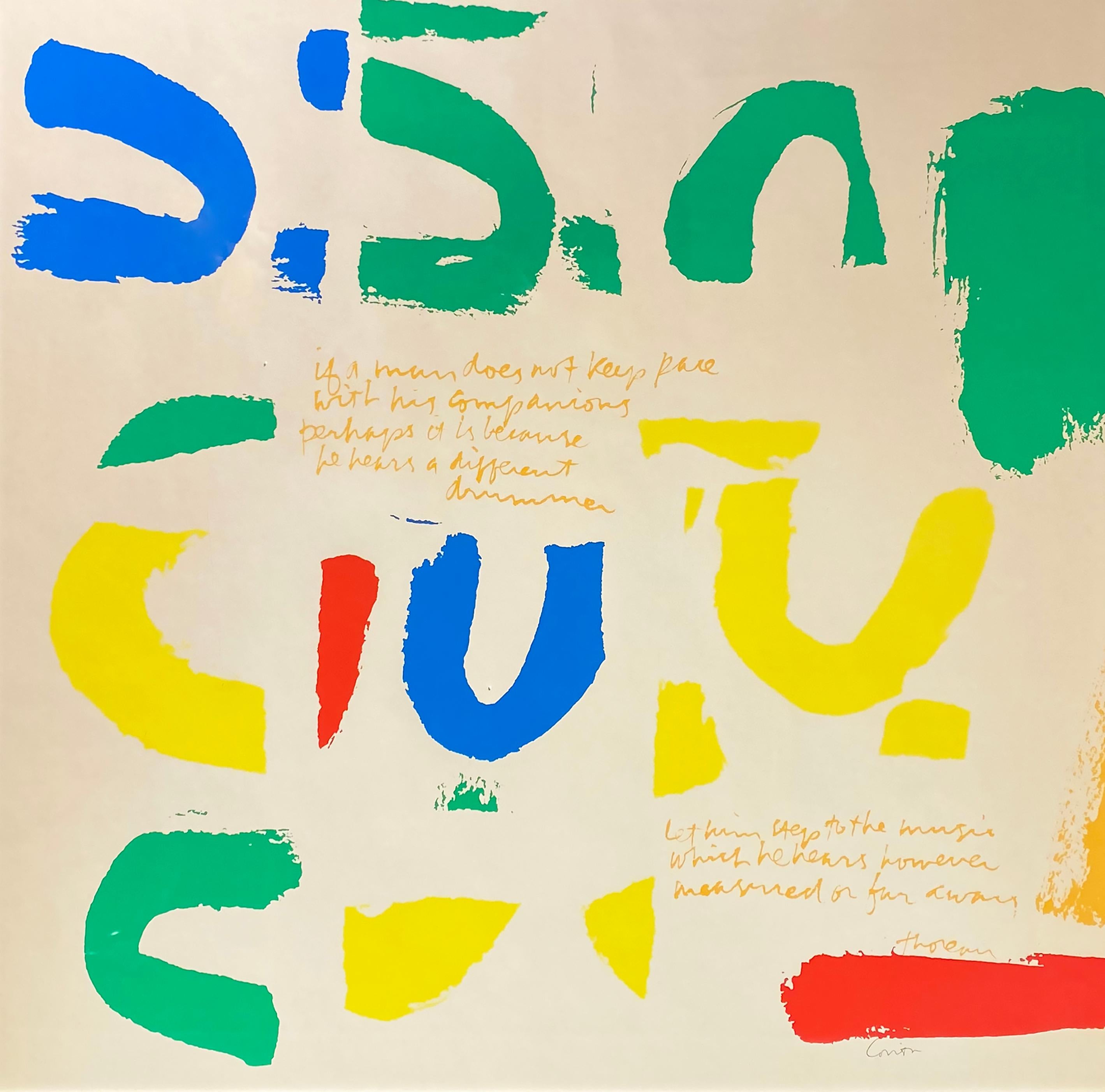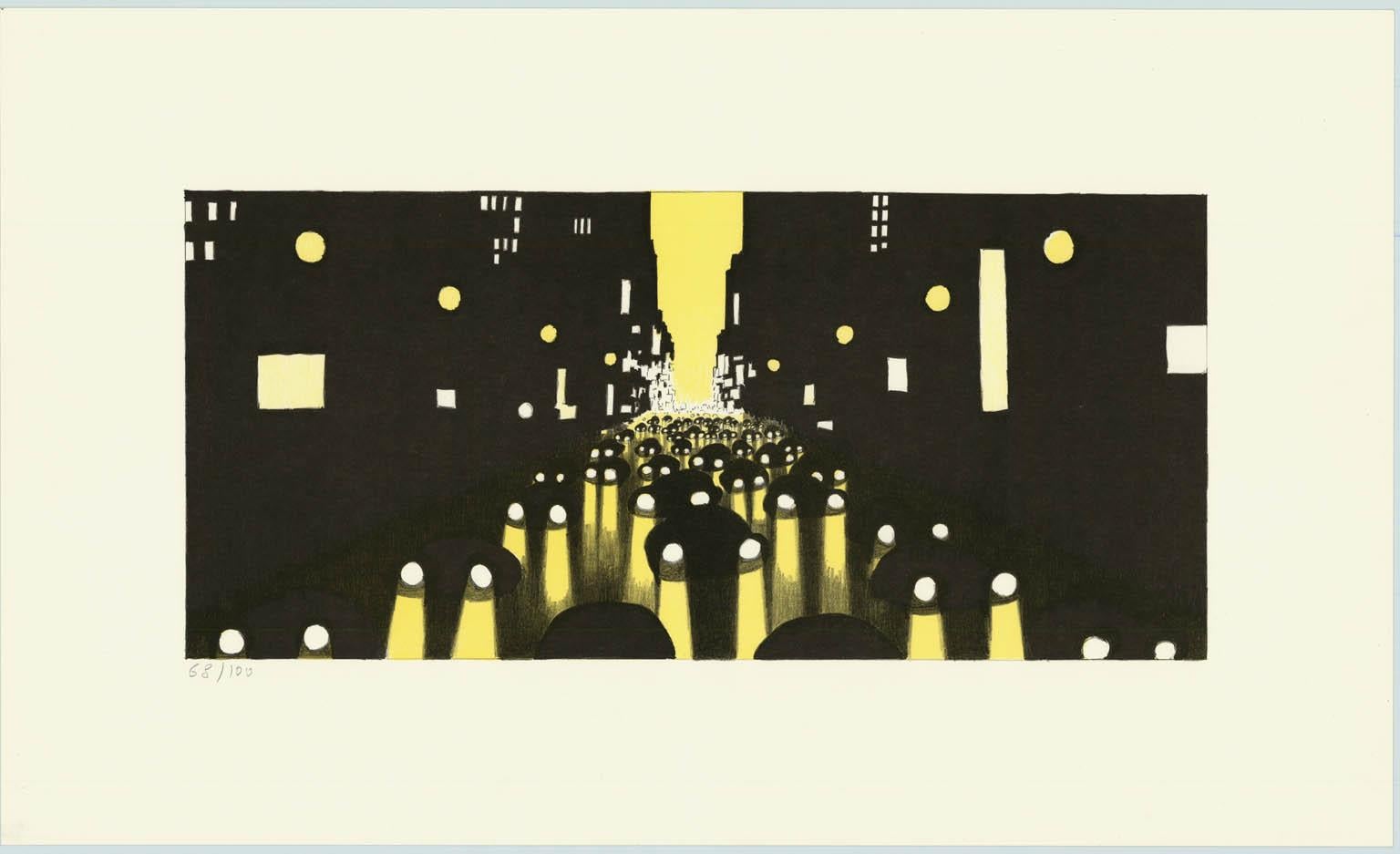Claes OldenburgColossal Flashlight in Place of Hoover Dam1982
1982
About the Item
- Creator:Claes Oldenburg (1929, American, Swedish)
- Creation Year:1982
- Dimensions:Height: 23 in (58.42 cm)Width: 22 in (55.88 cm)
- Medium:
- Movement & Style:
- Period:
- Condition:
- Gallery Location:Missouri, MO
- Reference Number:1stDibs: LU747311781222
Claes Oldenburg
One of the original Pop artists, Claes Oldenburg was born in Stockholm. The son of a Swedish diplomat, he spent his early years in Stockholm and Oslo until the family moved to Chicago in 1937.
Oldenburg attended Yale University, then returned to Chicago, where he worked for a newspaper and also attended drawing classes at the Art Institute. He moved to New York in 1956.
Oldenburg’s early art in New York were works of urban realism in cardboard and paper that were influenced by the work of Dubuffet and the New Realists, and were seen as a brutal response to society. In 1961 Oldenburg rented a storefront on the Lower East Side and sold brightly painted plaster objects as well as three-dimensional and wall reliefs based on hamburgers, pastries, men's and women's clothing, and other commodities. The signature soft sculptures followed, objects of commonplace household objects made of vinyl or canvas stuffed with kapok. These pieces transformed the medium — the soft sculptures are intended to be sensual experiences and commentary on our material world of objects and our relationship to them.
In 1965, still working in vinyl, plaster and cardboard, Oldenburg began making large works termed “Colossal Monuments,” which are large public sculptures with public and private meanings. In the 1970s, Oldenburg was fabricating large-scale works in durable materials such as steel, and working with Coosje van Bruggen, he had received many such public commissions in the United States and Europe.
Find authentic Claes Oldenburg sculptures, prints and other art on 1stDibs.
(Biography provided by Art Commerce)
- ShippingRetrieving quote...Ships From: Missouri, MO
- Return PolicyA return for this item may be initiated within 2 days of delivery.
- Thoreau "If a Man Does Not Keep Peace"By Corita KentLocated in Missouri, MOThoreau "If a Man Does Not Keep Peace" Sister Mary Corita Kent (American, 1918-1986) Signed in Pencil Lower Right 22.5 x 22.5 inches 23.25 x 23.25 inches with frame Sister Mary Cori...Category
20th Century American Modern Abstract Prints
MaterialsColor, Lithograph
- Leo Baeck "and a Spirit is Characterized"By Corita KentLocated in Missouri, MOLeo Baeck and a Spirit is Characterized Sister Mary Corita Kent (American, 1918-1986) Signed Lower Right in Pencil Edition of 250 Lower center 21.5 x 21.5 inches 24 x 24 inches frame...Category
20th Century American Modern Abstract Prints
MaterialsColor, Lithograph
- Observador de PajarosBy Rufino TamayoLocated in Missouri, MO"Observador de Pajaros" 1950 By. Rufino Tamayo (Mexican, 1899-1991) Edition 83/210 Lower Right Signed Lower Left Unframed: 15.5" x 22.5" Framed: 21.75" x 28.25" Rufino Tamayo (August 26, 1899- June 24, 1991) A native of Oaxaca in Southern Mexico, Rufino Tamayo's father was a shoemaker, and his mother a seamstress. Some accounts state that he was descended from Zapotec Indians, but he was actually 'mestizo' - of mixed indigenous/European ancestry. (Santa Barbara Museum of Art). He began painting at age 11. Orphaned at the age of 12, Tamayo moved to Mexico City, where he was raised by his maternal aunt who owned a wholesale fruit business. In 1917, he entered the San Carlos Academy of Fine Arts, but left soon after to pursue independent study. Four years later, Tamayo was appointed the head designer of the department of ethnographic drawings at the National Museum of Archaeology in Mexico City. There he was surrounded by pre-Colombian objects, an aesthetic inspiration that would play a pivotal role in his life. In his own work, Tamayo integrated the forms and tones of pre-Columbian ceramics into his early still lives and portraits of Mexican men and women. In the early 1920s he also taught art classes in Mexico City's public schools. Despite his involvement in Mexican history, he did not subscribe to the idea of art as nationalistic propaganda. Modern Mexican art at that time was dominated by 'The Three Great Ones' : Diego Rivera, Jose Clemente Orozco, and David Alfaro Siqueros, but Tamayo began to be noted as someone 'new' and different' for his blending of the aesthetics of post Revolutionary Mexico with the vanguard artists of Europe and the United States. After the Mexican Revolution, he focused on creating his own identity in his work, expressing what he thought was the traditional Mexico, and refusing to follow the political trends of his contemporary artists. This caused some to see him as a 'traitor' to the political cause, and he felt it difficult to freely express himself in his art. As a result, he decided to leave Mexico in 1926 and move to New York, along with his friend, the composer Carlos Chavez. The first exhibition of Tamayo's work in the United States was held at the Weyhe Gallery, New York, in that same year. The show was successful, and Tamayo was praised for his 'authentic' status as a Mexican of 'indigenous heritage', and for his internationally appealing Modernist aesthetic. (Santa Barbara Museum of Art). Throughout the late thirties and early forties New York's Valentine Gallery gave him shows. For nine years, beginning in 1938, he taught at the Dalton School in New York. In 1929, some health problems led him to return to Mexico for treatment. While there he took a series of teaching jobs. During this period he became romantically involved with the artist Maria...Category
20th Century Abstract Abstract Prints
MaterialsLithograph
- Red and Blue SpiralsBy Alexander CalderLocated in Missouri, MORed and Blue Spirals Alexander Calder (American, 1898-1976) Signed in Pencil Lower Right Numbered 59/150 in Pencil Lower Left 26 x 37 inches 35.5 x 46 inches with frame One of Amer...Category
1970s Abstract Abstract Prints
MaterialsColor, Lithograph
- Blue Rings (Abstract Composition)By Yaacov AgamLocated in Missouri, MOBlue Rings (Abstract Composition), Serigraph By Yaacov Agam (Israeli, b. 1928) Signed Lower Right Edition 8/270 Lower Left Unframed: 21" x 21.5" Framed: 31" ...Category
20th Century Abstract Abstract Prints
MaterialsLithograph
- CurtainBy Yaacov AgamLocated in Missouri, MOCurtain By. Yaacov Agam (Israeli, b. 1928) Signed Lower Right Edition 221/227 Unframed: 18" x 22.5" Framed: 30.5" x 34.5" Yaacov Agam is one of the pioneer creators of the kinetic movement in art as well as its most outstanding contemporary representative. Agam was born in 1928 a son of a Rabbi of Rishon LeZion (Israel), who devoted his life to the study of Jewish religious matters and wrote books. Agam considers himself somehow as a visual continuation of his father's quest for spirituality. He studied at the Bezalel Academy of Art in Jerusalem, and in Switzerland at the Eidgenossische Technische Hochschule and the Zurich University. After arriving to Paris in 1951, Agam held his first one man exhibition with a great success in 1953 This exhibition consisted totally of kinetic, movable and transformable paintings, which actually was the first one-man show in art history exclusively devoted to kinetic art. A passionate experimenter, Agam deals with such problems as the 4th dimension, simultaneity and time in the visual, plastic arts, and has extended his experiments to application in the fields of literature, music and art theory. His works express a concept that breaks away with the established way of expressing reality in limited, static way. In his works, he strives to demonstrate the principle of reality as a continuous "becoming" rather than static "graven image." His paintings Double Metamorphosis 11 in the Museum of Modern Art in New York and Transparent Rhythms 11 in the Hirshhorn Museum and Sculpture Garden of the Smithsonian Institution in Washington, D.C. give the best example of his polymorphic painting. His works are placed in many public places including Communication x 9 on the Michigan Avenue in Chicago (1983), Communication: Night and Day at the AT&T building in New York (1974), Super Lines Volumes at the Pare Floral in Paris (1971), and his murals Peace and Life arc installed at the Parliament of Europe in Strasbourg (1977). Agam has expressed the new concepts in monumental works as in his Jacob's Ladder, which forms the ceiling of the National Convention House in Jerusalem. He created a "floating museum", including all the artworks for public areas and cabins, for the Carnival Cruise Line's luxury cruise ship "Celebration" (1987). His fire-water fountain in Dizengoff Square in Tel Aviv (1986) streams water, fire, and music -elements of flux and life which cannot be static - as its colored elements rotate in this multidimensional monumental work. For the Elysee Palace in Paris, with the request of President Georges Pompidou Agam created in 1972 a whole environmental of the Salon with the walls covered with polymorphic murals of changing images a kinetic ceiling, moving transparent colored doors and a kinetic carpet on which he placed a sculpture. It embraces viewers: they are no longer looking at a framed, fixed scene, but rather arc moving within an artistic space which changes constantly according to their shifting position and point of view. Similar attempt was made for the concert hall, Forum Leverkusen in Germany in 1970. Agam created many environmental sculptures, including Hundred Gates in the garden of the residence of the President of Israel in Jerusalem, 3 x 3 Interplay installed at the Julliard School of Music at the Lincoln Center and Wings of the Heart at J. F. Kennedy airport in New York. In 1984, he made a sculpture Beating Heart for the Hadassah Hospital in Jerusalem. In 1988, he created a transparent torah ark...Category
20th Century Abstract Abstract Prints
MaterialsLithograph
- Original Innsbruck '76 winter Olympic Games vintage posterLocated in Spokane, WAInnsbruck '76 original Olympics posters. Tirol Austria 1976. Winter Games. Original Olympic poster. Linen-backed. Published by Organizat...Category
1970s American Modern Abstract Prints
MaterialsLithograph
- Original Skarby Sultana a.k.a. The Story of Little Muck vintage posterLocated in Spokane, WAOrignial Skarby Sultana vintage poster. A.k.a.The Story of Little Much. Archival linen-backed Very good condition A. Bright and vibrant, lithograph, no stains, no damage, no...Category
1950s American Modern Abstract Prints
MaterialsLithograph
- Crosstown TrafficBy Emilio SanchezLocated in New York, NY“Crosstown Traffic” is a color lithograph by Emilio Sanchez. Created in 1998, this impression is unsigned and came to us directly from the Emilio Sanchez Estate (circular estate stam...Category
Late 20th Century American Modern More Prints
MaterialsLithograph
- Two Women Bathing Child IIBy Henry MooreLocated in New York, NYA very good impression of this color lithograph. One of 25 numbered artist's proofs, aside from the edition of 50. Signed, inscribed "AP" and numbered X/XXV in pencil by Moore. Print...Category
1970s Modern Abstract Prints
MaterialsColor, Lithograph
- Senza titolo (Concetto Spaziale)By Lucio FontanaLocated in New York, NYA very good impression of this color photolithograph with strong colors on Magnani Pescia paper. Signed and numbered 101/150 in pencil by Fontana. Printed by Le Arte Grafiche Pardini...Category
1960s Modern Abstract Prints
MaterialsColor, Lithograph
- Forehead IIBy James RosenquistLocated in New York, NYA very good impression of this early color lithograph on Arches paper. One of 6 numbered artist's proofs, aside from the edition of 96. Signed, titled, dated, inscribed "Artist's Pro...Category
1960s Modern Abstract Prints
MaterialsColor, Lithograph






